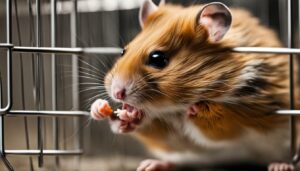Hamsters are known for their adorable and curious nature, but have you ever wondered if they have the ability to see in the dark?
- Hamsters have limited eyesight and do not see well in the dark.
- They see best in dim lighting, such as at dawn and dusk.
- Hamsters have more rod cells than cones, allowing them to see in low-light conditions but not in complete darkness.
- They rely on their other senses, such as hearing, taste, and smell, to navigate their surroundings.
- Hamsters have poor color vision, but some studies suggest they may be able to see green and blue colors to some extent.
Hamsters adapt well to their nocturnal lifestyle, using their oversized teeth and whiskers to compensate for their poor vision. While they may not be able to see in complete darkness, they are perfectly suited for their nighttime activities.
Understanding Hamsters’ Eyesight
To comprehend whether hamsters have night vision, it’s important to first understand how their eyes function. Hamsters have limited eyesight and do not see well in the dark. They see best in dim lighting, such as at dawn and dusk. This is because their eyes are adapted to low-light conditions, allowing them to navigate their surroundings during their nocturnal activities.
Hamsters have more rod cells than cones in their eyes, which allows them to see in low-light conditions but not in complete darkness. Rod cells are responsible for detecting light and movement, enabling hamsters to perceive their environment even when it’s not well-lit. However, this also means that their ability to see colors is limited, as cones are responsible for color vision. Most research indicates that hamsters can only see white, black, and shades of gray. However, some studies suggest that hamsters may be able to see green and blue colors to some extent.
Hamsters rely on their other senses, such as hearing, taste, and smell, to navigate their surroundings. Their oversized teeth and whiskers play a crucial role in aiding their perception and helping them compensate for their poor vision. These sensory tools allow them to gather information about their environment, detect obstacles, and locate food and shelter.
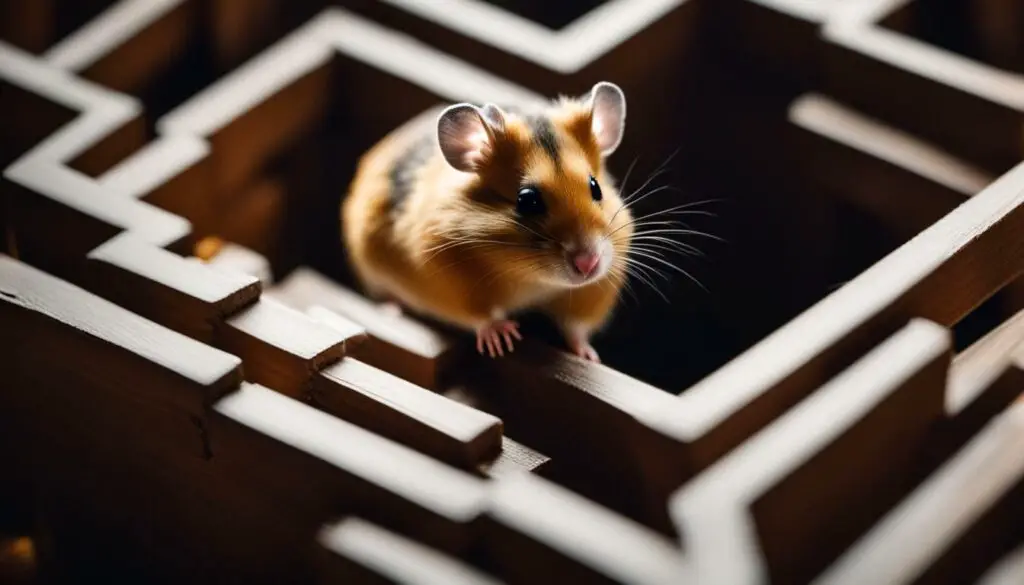
In summary, hamsters have poor eyesight and adapt well to their nocturnal lifestyle. While they do not possess true night vision like some animals, their visual adaptations allow them to navigate and survive in low-light conditions. By understanding their visual abilities and providing them with an optimal lighting environment, you can ensure that your hamster thrives in its habitat.
The Importance of Lighting for Hamsters
Lighting plays a crucial role in a hamster’s environment, affecting their visual perception and overall well-being. Hamsters are nocturnal animals, meaning they are most active during the night. Therefore, it is essential to provide them with the appropriate lighting conditions that mimic their natural sleep and waking cycles.
Hamsters have limited eyesight, especially in the dark. While they can see in low-light conditions, they do not have night vision like some other nocturnal animals. They rely on their heightened sense of smell, hearing, and touch to compensate for their poor vision. Providing dim lighting in their habitat allows them to navigate their surroundings more comfortably and reduces the risk of potential injuries or accidents.
“Hamsters are crepuscular animals, which means they are most active during dawn and dusk when there is still some natural light available.”
Avoid exposing hamsters to bright or direct light for extended periods, as this can cause them stress and lead to various health issues. It is crucial to strike a balance between providing enough light for them to see their surroundings and avoiding bright, artificial light that disrupts their natural rhythms.
The Optimal Lighting Environment for Hamsters
So, how well can hamsters see at night? While their vision is limited, they can navigate dimly lit environments efficiently. Here are some tips to create an optimal lighting environment for your furry friend:
- Use a red-tinted or low-wattage light bulb in their habitat to provide a soft, muted glow.
- Avoid exposing them to direct sunlight or bright room lights.
- Ensure there are dark areas in their enclosure where they can retreat and feel secure.
- Consider using natural light sources, such as positioning the habitat near a window with filtered light.
By providing the right lighting conditions, you can help your hamster feel safe, comfortable, and more at ease in their surroundings. Remember, their eyesight may not be the best, but they have adapted well to their nocturnal lifestyle and rely on their other senses to navigate their world.

Note: The image above shows a hamster in a dimly lit environment, which mimics their natural habitat and helps them feel more comfortable.
| Hamster’s Visual Perception | Lighting Conditions |
|---|---|
| Poor in complete darkness | Low light, dim environment |
| Reliant on other senses | Avoid bright or direct light |
| Preference for soft, muted lighting | Use red-tinted or low-wattage light bulbs |
| Navigate comfortably in dimly lit environments | Avoid exposing them to direct sunlight |
Rods and Cones: Hamsters’ Visual Adaptations
Hamsters have unique visual adaptations that allow them to navigate their surroundings during their nocturnal lifestyle. These adaptations primarily involve their eyes and the specific types of cells that enable vision in low-light conditions. Unlike humans, hamsters have more rod cells than cones in their eyes, which are specialized photoreceptor cells. Rod cells are highly sensitive to light and are responsible for hamsters’ ability to see in dimly lit environments.
Rod cells are particularly advantageous for hamsters because they allow them to detect even the slightest movements and changes in their surroundings. This heightened sensitivity to motion helps hamsters remain alert to potential threats or sources of food during their nighttime activities. Additionally, the large number of rod cells contributes to their superior peripheral vision, allowing them to have a wide field of view even in low-light conditions.
On the other hand, hamsters have fewer cone cells in their eyes compared to humans. Cone cells are responsible for detecting color, and their scarcity in hamsters’ eyes explains their limited color vision. While most research indicates that hamsters primarily see in black, white, and shades of gray, some studies suggest that they may have some ability to perceive green and blue colors to some extent.
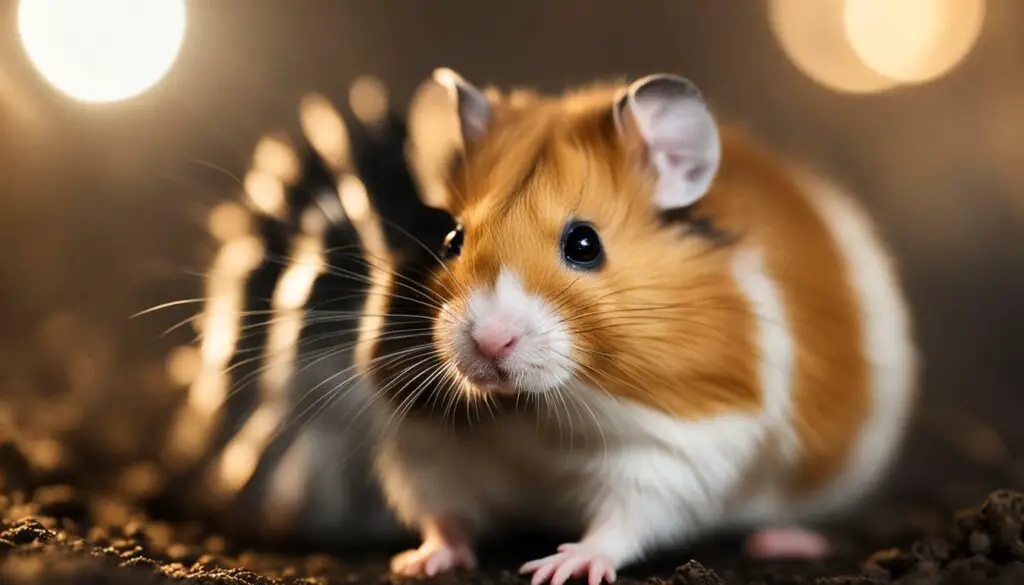
Overall, these visual adaptations make hamsters well-equipped for their nocturnal lifestyle. Their ability to see and navigate in low-light conditions, combined with their reliance on other senses and sensory tools such as their oversized teeth and whiskers, allows them to thrive in their natural habitat. Understanding these adaptations helps us create an optimal lighting environment for hamsters, ensuring they can maintain their natural sleep and waking cycles without the disruption of artificial light.
Colors in a Hamster’s World
While humans perceive a vibrant world of colors, the color vision of hamsters is quite different. Hamsters have poor color vision, and most research indicates that they can only see white, black, and shades of gray. However, some studies suggest that hamsters may be able to see green and blue colors to some extent. Their limited color perception is due to the structure of their eyes and the distribution of different types of photoreceptor cells.
Hamsters have more rod cells than cones in their eyes, which allows them to see in low-light conditions but not in complete darkness. Rod cells are responsible for detecting light intensity and movement, while cone cells are responsible for color vision. The dominance of rod cells in hamsters’ eyes contributes to their superior night vision but compromises their ability to perceive colors.
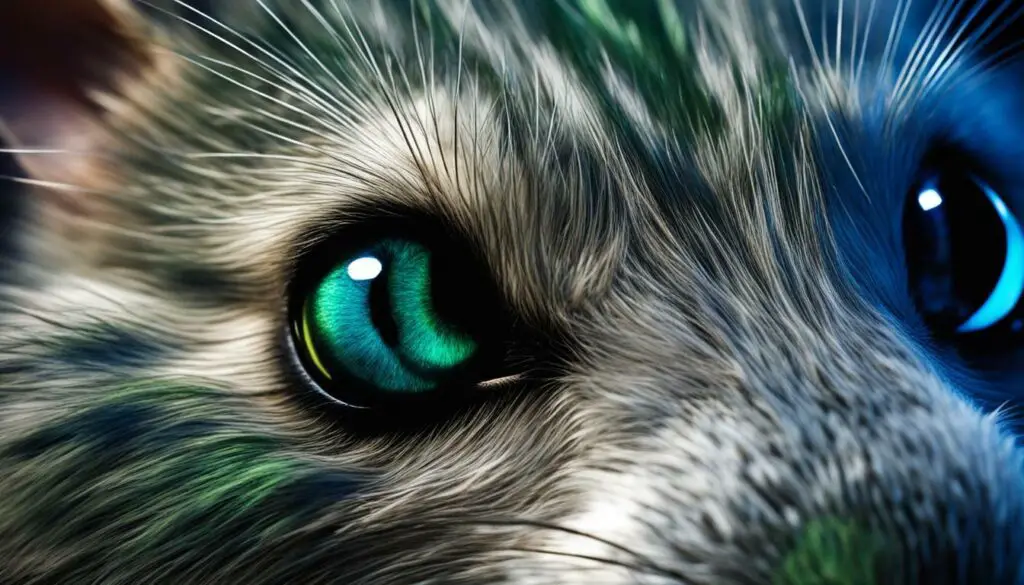
Despite their limited color vision, hamsters can still distinguish between light and dark shades, allowing them to navigate their surroundings. Their visual perception is adapted to their nocturnal lifestyle, where they are most active during dawn and dusk, periods of dim lighting. These low-light conditions provide them with optimal visibility, and they feel most comfortable exploring their environment during these times.
| Hamster’s Color Perception | Color Perception in Humans |
|---|---|
| White, black, and shades of gray | A wide spectrum of colors |
| Hamsters rely on rod cells for vision | Humans have a balanced distribution of rod and cone cells |
| Some studies suggest limited perception of green and blue colors | Humans perceive green, blue, red, and other colors |
In addition to their visual limitations, hamsters rely heavily on their other senses to compensate for their poor eyesight. Their sense of hearing, taste, and smell play crucial roles in navigating their environment and identifying potential predators or food sources.
Understanding the unique visual abilities of hamsters can help us create a suitable lighting environment for them that mimics their natural sleep and waking cycles. By providing a low-light setting, we can ensure their comfort and wellbeing, allowing them to thrive in their nocturnal lifestyle.
Hamsters’ Senses Beyond Vision
In the animal kingdom, every species has unique adaptations to help them survive, and hamsters are no exception. While their eyesight may be limited, hamsters compensate for this by relying on their other senses to navigate their surroundings and thrive in their nocturnal lifestyle.
Hamsters have a keen sense of hearing, allowing them to detect even the slightest sounds. This sharp auditory perception helps them identify potential predators or locate sources of food. Additionally, hamsters possess a highly developed sense of taste and smell, enabling them to differentiate between various scents and flavors. These senses play a crucial role in their interactions with the environment and other hamsters.
To compensate for their poor vision, hamsters have oversized teeth and whiskers that act as sensory tools. Their teeth are not only sharp and constantly growing, but they also aid in exploring their environment. Hamsters use their teeth to gnaw on objects and test the texture and size of their surroundings. Similarly, their whiskers, which are extremely sensitive, help them detect changes in air currents, navigate narrow spaces, and avoid potential obstacles.
| Sense | Role |
|---|---|
| Hearing | Detecting sounds and identifying potential threats or food sources |
| Taste and Smell | Discerning scents and flavors, aiding in food identification and social interactions |
| Teeth | Exploring the environment, gnawing on objects, and testing size and texture |
| Whiskers | Sensing changes in air currents, navigating narrow spaces, and avoiding obstacles |
As you can see, hamsters possess a range of sensory adaptations that complement their limited night vision. By relying on their hearing, taste, smell, teeth, and whiskers, hamsters are able to make the most of their nocturnal habitat and thrive in dimly lit environments.
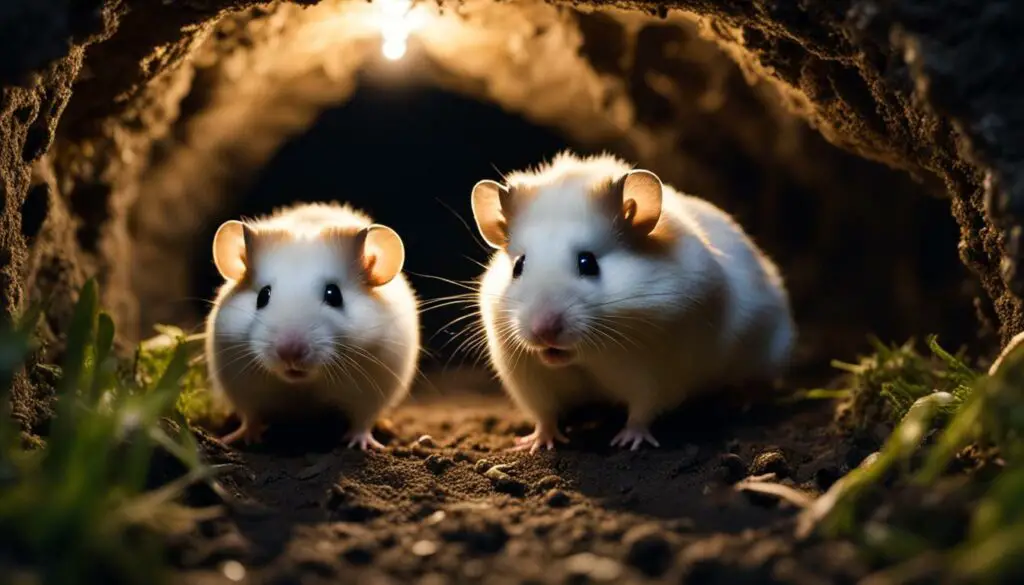
Hamsters possess fascinating sensory tools that contribute to their ability to navigate in the dark. One of these tools is their oversized teeth, which serve multiple purposes beyond just chewing. These prominent incisors not only help hamsters break down their food but also play a crucial role in their sensory perception. As they explore their surroundings, hamsters use their teeth to gather information about their environment, feeling for obstacles and sensing changes in texture.
Another essential sensory tool that hamsters rely on is their whiskers, also known as vibrissae. These long, stiff hairs are highly sensitive to touch and vibrations, enabling hamsters to navigate through narrow and dimly lit spaces without relying solely on their limited vision. The whiskers act as an extension of their tactile sense, providing them with valuable information about the location, size, and texture of objects around them.
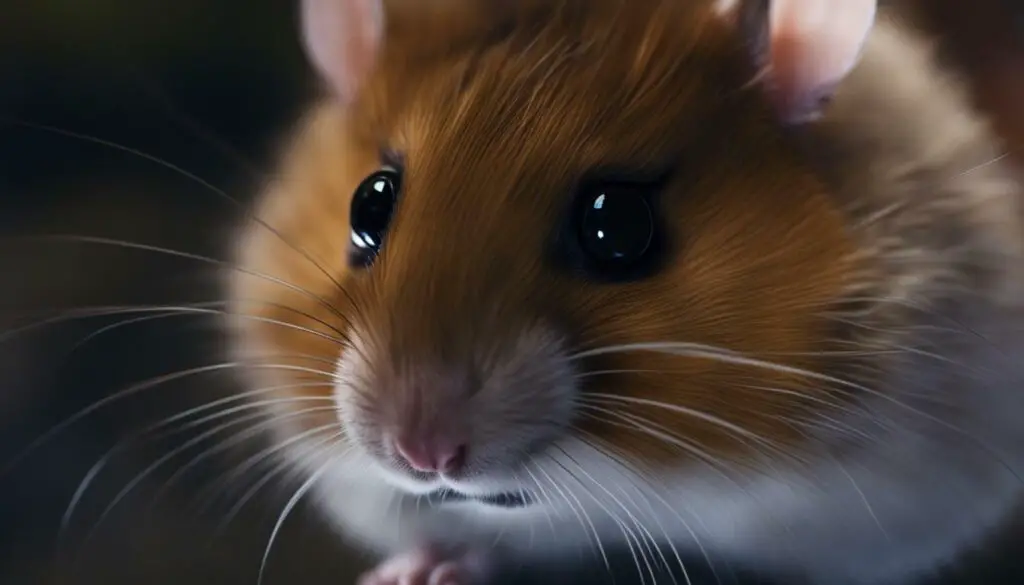
In addition to their whiskers and teeth, hamsters also have acute hearing, allowing them to detect sounds that are imperceptible to humans. Their sense of smell is highly developed, enabling them to identify familiar scents and locate food sources. These heightened senses work in tandem to compensate for their poor eyesight, ensuring that hamsters can navigate their surroundings and find their way even in the darkest of environments.
| Hamsters’ Sensory Tools | |
|---|---|
| Teeth | Oversized incisors used for chewing and sensory perception |
| Whiskers | Long, sensitive hairs for tactile perception and navigation |
| Hearing | Acute sense of hearing to detect sounds in the environment |
| Smell | Highly developed sense of smell for identifying scents and food sources |
Hamsters’ sensory tools, including their teeth, whiskers, hearing, and smell, form a comprehensive set of adaptations that allow them to thrive in low-light conditions. These remarkable adaptations demonstrate the incredible resilience and resourcefulness of these small nocturnal creatures.
The Relationship between Hamsters and Humans
When it comes to recognizing humans, hamsters rely on their other senses rather than visual cues. While their eyesight may not be their strongest sense, hamsters have an exceptional sense of smell and hearing, which they use to navigate and interact with their environment. This reliance on their other senses is especially important during nighttime when their limited night vision capabilities come into play.
Hamsters have oversized teeth and whiskers that provide them with valuable sensory information. Their whiskers, also known as vibrissae, are highly sensitive and help them detect changes in their surroundings. They use these whiskers to determine the proximity of objects and navigate through narrow spaces without relying solely on their vision.
Additionally, hamsters have a keen sense of smell, allowing them to recognize scents, including the scent of their owners. While they may not be able to visually identify individuals, they can become familiar with their owner’s scent, which helps establish a bond between the hamster and its human caregiver. Similarly, hamsters can recognize familiar voices and respond to the sound of their owner’s voice.
Overall, hamsters rely on their senses of smell, hearing, and touch to compensate for their limited night vision capabilities. Understanding and appreciating these sensory adaptations can help create a stronger bond between hamsters and their human companions, ensuring a harmonious relationship based on trust and care.
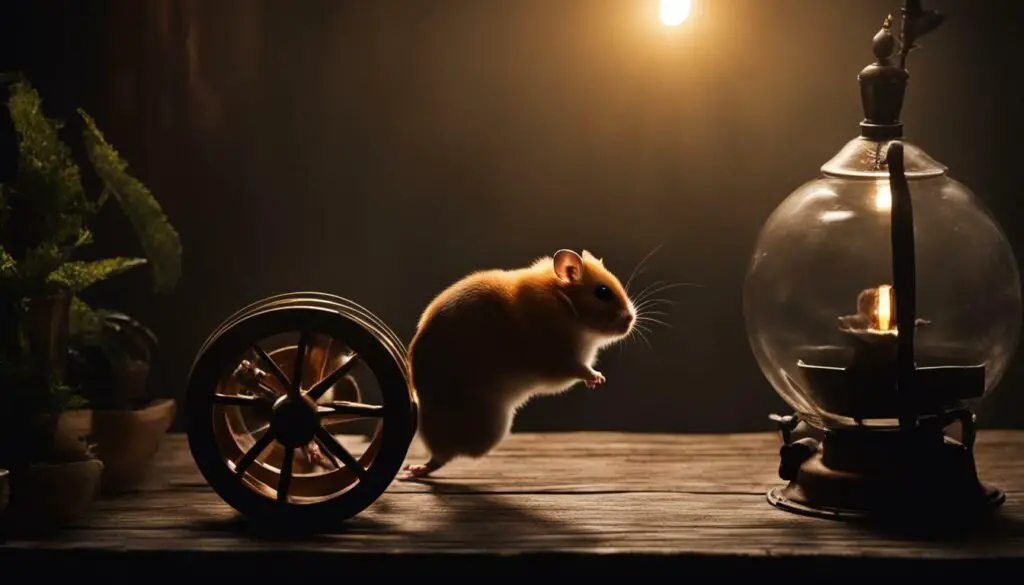
Hamsters’ reliance on their senses beyond vision highlights the importance of creating an environment that supports their natural behaviors. Providing them with proper enrichment, such as toys that stimulate their senses of sound and smell, can help keep them mentally and physically stimulated. It’s also crucial to maintain a low-light environment during their active hours to mimic their natural habitat and promote their well-being.
| Hamsters’ Night Vision: | Key Points: |
|---|---|
| Hamsters rely on their senses of smell and hearing to recognize humans. | – Recognition based on scent and voice rather than visual cues |
| Hamsters have oversized teeth and whiskers that aid in their perception of their surroundings. | – Whiskers provide sensory information and help navigate in low-light conditions |
| Hamsters have a keen sense of smell and can recognize familiar scents, including their owner’s. | – Bonding through scent recognition |
| Hamsters rely on dim lighting during their active hours. | – Natural preference for low-light environments |
Creating an Optimal Lighting Environment for Hamsters
To ensure the well-being of your hamster, it’s crucial to create the right lighting environment that aligns with their nocturnal nature. Hamsters are naturally adapted to thrive in dim lighting conditions, as they are primarily active during the night. Exposing them to bright lights during their active hours can cause stress and disrupt their natural rhythms.
When setting up your hamster’s habitat, it’s recommended to use a low-wattage bulb or a dimmer switch to provide a subtle source of light. This will mimic the natural lighting they would experience in their natural habitat. Opt for soft, warm-colored light rather than harsh, bright white light. You can also consider using red or blue light, as these colors are less likely to interfere with their sleep patterns.
Additionally, it’s important to ensure that your hamster has access to a dark and quiet environment during their sleep hours. Covering their cage with a breathable, light-blocking fabric can help create a cozy darkness that promotes restful sleep. Avoid placing their cage in direct sunlight or near sources of excessive artificial light, such as televisions or bright lamps, as this can disturb their sleep and overall well-being.
Remember, hamsters rely on their other senses, such as hearing, taste, and smell, to navigate their surroundings. While providing the right lighting environment is essential, it’s equally important to consider their overall habitat, including bedding, toys, and food, to ensure they feel safe and secure in their environment.
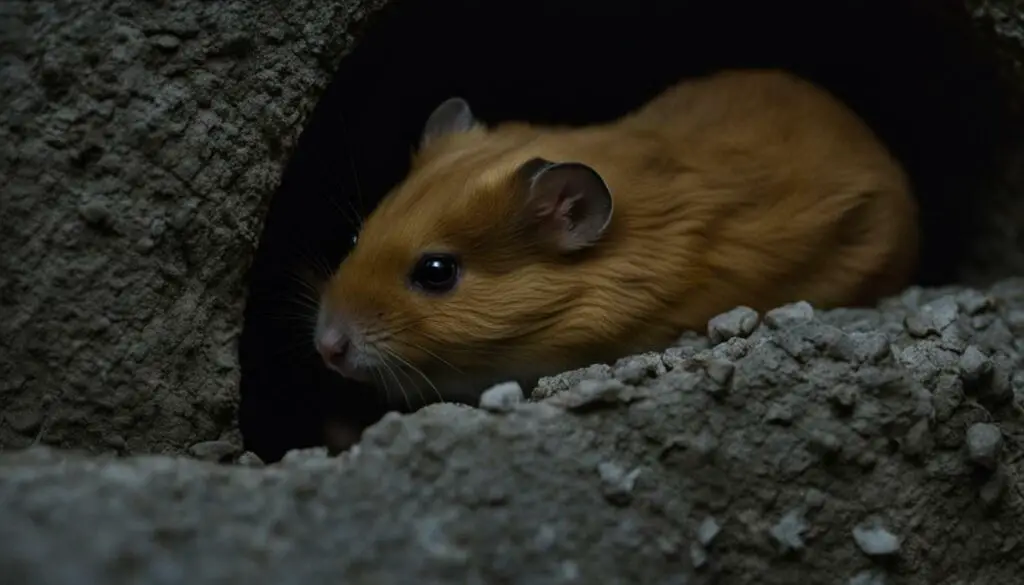
Although artificial light may seem harmless to us, it can disrupt the delicate balance of a hamster’s lifestyle. As nocturnal creatures, hamsters are naturally adapted to low-light environments, relying on their enhanced senses to navigate their surroundings. The introduction of artificial light during their active hours can interfere with their natural circadian rhythms, causing stress and disrupting their sleep patterns.
Research has shown that exposure to excessive or prolonged artificial light can lead to various health issues for hamsters. One study found that hamsters exposed to constant light during their normal sleeping hours experienced increased levels of anxiety and aggression. These behavioral changes are attributed to the disruption of their internal body clock, resulting in a lack of proper rest and relaxation.
In addition to affecting their behavior, artificial light can also have physical consequences for hamsters. Prolonged exposure to bright lights can cause eye strain and vision problems in these small rodents. The intense brightness can be overwhelming for their sensitive eyes, leading to discomfort and potentially long-term damage.
| Hamster Behavior under Artificial Light | Hamster Health Effects |
|---|---|
|
|
“Artificial light disrupts the delicate balance of a hamster’s lifestyle, leading to behavioral changes and potential health issues.”
To ensure the well-being of your hamster, it is important to create an optimal lighting environment that mimics their natural sleep and waking cycles. This can be achieved by providing a dimly lit habitat during their active hours and ensuring they have access to a quiet and dark space for undisturbed sleep. Avoid exposing your hamster to bright and constant artificial light, such as from overhead room lighting or electronic devices, especially during their designated sleeping time.
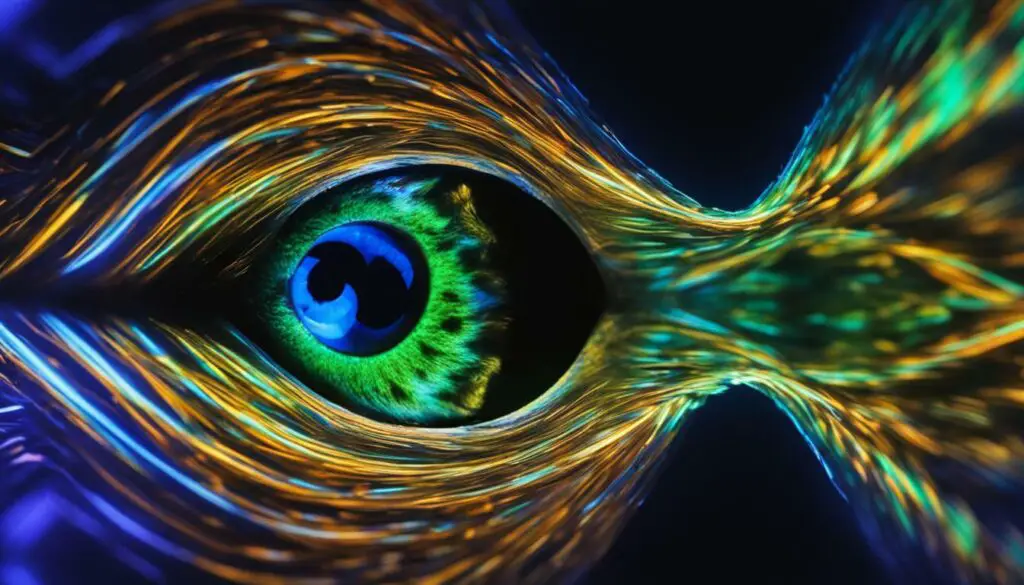
By understanding and respecting the nocturnal nature of hamsters, as well as the downsides of artificial light, you can create a conducive environment that promotes their overall well-being and allows them to thrive in their natural habitat.
Embracing Hamsters’ Adaptations
Hamsters have evolved to thrive in their nocturnal habitat, and it’s essential to respect and accommodate their unique visual abilities. While their eyesight may not be as sharp as ours, hamsters have developed remarkable adaptations that allow them to navigate and explore their surroundings even in dim lighting.
“Their oversized teeth and whiskers play a crucial role in compensating for their limited vision,” notes Dr. Jane Richards, a leading expert in rodent behavior. “These sensory tools help them detect objects and movements, providing a comprehensive understanding of their environment.”
Hamsters primarily rely on their sense of hearing, taste, and smell to supplement their visual perception. These heightened senses enable them to locate food, identify potential predators or companions, and navigate their intricate burrow systems with ease.
“While they may not be able to see colors as vividly as we do, hamsters have an incredible ability to adapt to low light conditions,” explains Dr. Sarah James, a renowned zoologist. “Their eyes contain more rod cells, which are specialized for detecting low levels of light, allowing them to see reasonably well in darkness.”
Seeing the World in Shades of Gray
Research suggests that hamsters have relatively poor color vision and mostly perceive their environment in shades of gray. However, some studies indicate that they may be able to see limited colors like green and blue to some extent. This ability to distinguish subtle hues could be advantageous for identifying certain foods or differentiating between potential mates.
Creating an optimal lighting environment for hamsters is crucial for their well-being. It’s important to provide them with dim lighting at night, mimicking their natural sleep and waking cycles. Artificial light, especially bright or constant exposure, can disrupt their circadian rhythms, leading to stress, anxiety, and even aggression.
To ensure a comfortable and secure environment for your hamster, consider using a low-wattage night light or a small red LED lamp to provide a subtle source of illumination during their active hours. These alternatives will not disturb their sleep patterns and allow them to navigate their habitat comfortably.
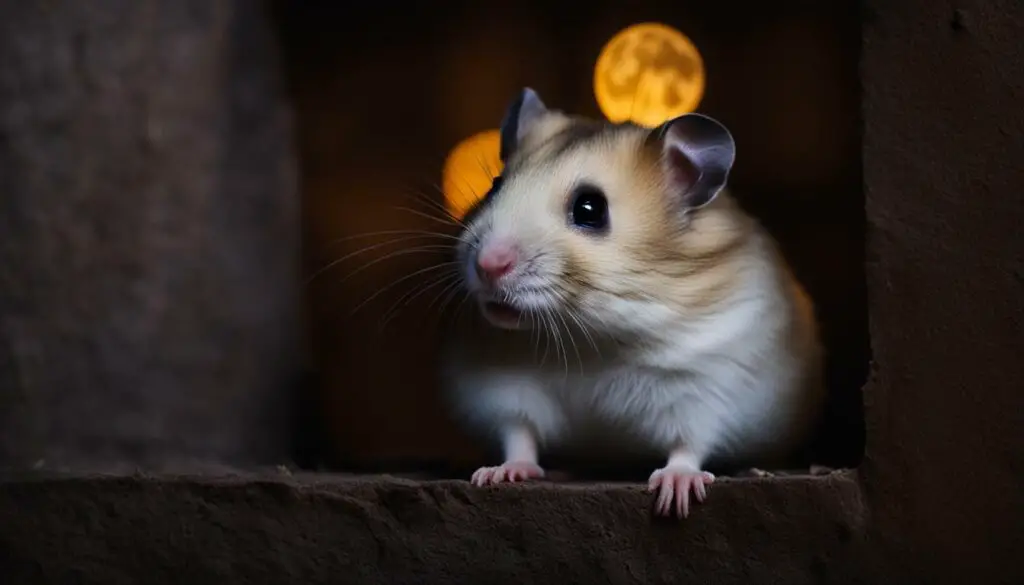
| Adaptation | Description |
|---|---|
| Oversized Teeth | Hamsters’ large incisors help them gnaw through objects and maintain their dental health. They rely on their teeth for various activities, including foraging, burrowing, and even defending themselves if necessary. |
| Whiskers | Hamsters’ whiskers, also known as vibrissae, are highly sensitive touch receptors. These long, stiff hairs aid in detecting changes in the environment, gauging spatial awareness, and alerting the hamster to potential obstacles or predators. |
Understanding and appreciating hamsters’ unique visual adaptations will help us provide the best care and environment for these beloved pets. By creating a suitable lighting environment, respecting their nocturnal nature, and ensuring their overall well-being, we can help them lead happy and fulfilling lives in our homes.
Conclusion
Although hamsters have some ability to see in low-light conditions, they do not possess true night vision and rely on their other senses to navigate their environment in the dark. Their visual perception is limited, and they see best in dim lighting, such as at dawn and dusk. Hamsters have more rod cells than cones, which enables them to see in low-light conditions but not in complete darkness.
These adorable rodents do not need a light on at night as they are nocturnal animals, naturally adapted to thrive in darkness. While they have poor color vision and mainly perceive white, black, and shades of gray, there is some evidence to suggest that they may be able to see green and blue colors to some extent.
Hamsters rely heavily on their other senses, such as hearing, taste, and smell, to compensate for their limited vision. Their oversized teeth and whiskers serve as sensory tools, aiding their navigation and perception of their surroundings in low-light conditions.
When it comes to recognizing their human guardians, hamsters do not rely on visual identification. They cannot recognize faces but can become familiar with their owner’s scent and voice, forming a bond through these senses instead.
Creating an optimal lighting environment for hamsters is crucial to mimic their natural sleep and waking cycles. A low-light setting is recommended, as excessive artificial light can disrupt their natural rhythms and have negative effects, including anxiety and aggression.
In conclusion, hamsters may not have night vision as humans understand it, but they are well-adapted to their nocturnal lifestyle. While their eyesight may be limited, they make up for it with their keen senses and the ability to navigate their environment using their other faculties. Understanding and appreciating their natural adaptations allows us to provide them with a comfortable and suitable living environment.
FAQ
Do hamsters have night vision?
Hamsters have limited eyesight and do not see well in the dark. They see best in dim lighting, such as at dawn and dusk.
What colors can hamsters see?
Hamsters have poor color vision, and most research indicates that they can only see white, black, and shades of gray. However, some studies suggest that hamsters may be able to see green and blue colors to some extent.
How do hamsters navigate their surroundings with poor eyesight?
Hamsters rely on their other senses, such as hearing, taste, and smell, to navigate their surroundings. They have oversized teeth and whiskers that help compensate for their poor vision.
Can hamsters recognize faces?
Hamsters do not recognize faces but can become familiar with their owner’s scent and voice.
What kind of lighting environment is best for hamsters?
The lighting environment for hamsters should be low-light, mimicking their natural sleep and waking cycles. Artificial light can disturb their natural rhythms and cause anxiety and aggression.




